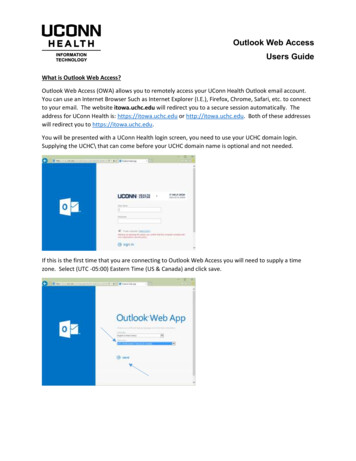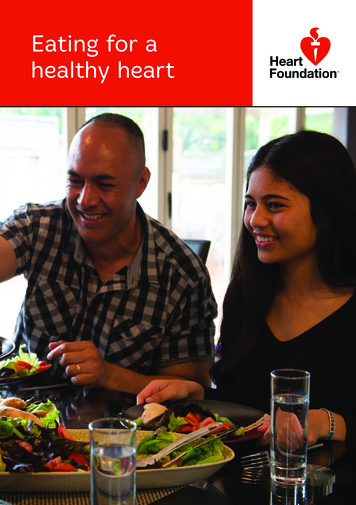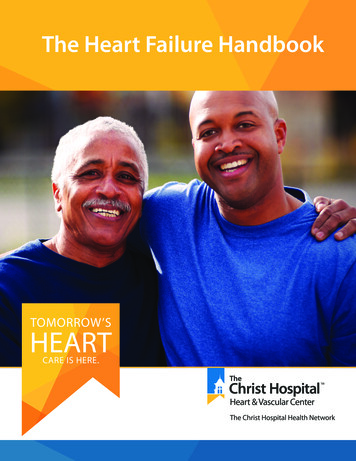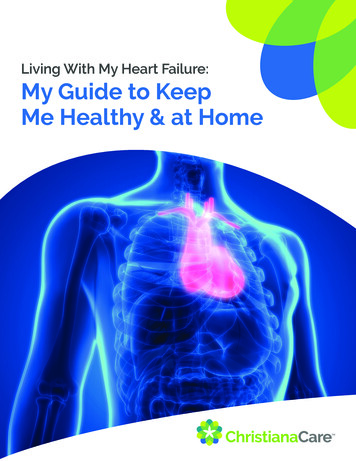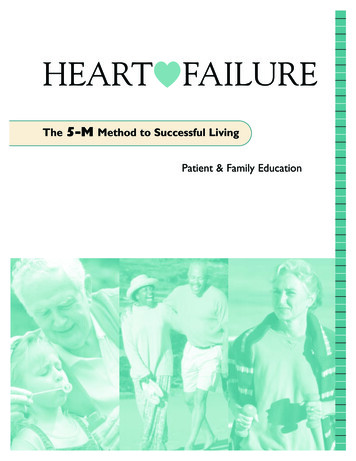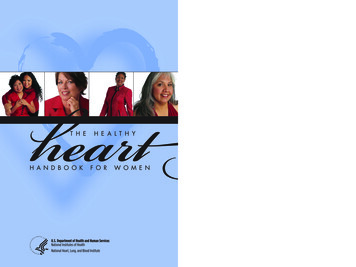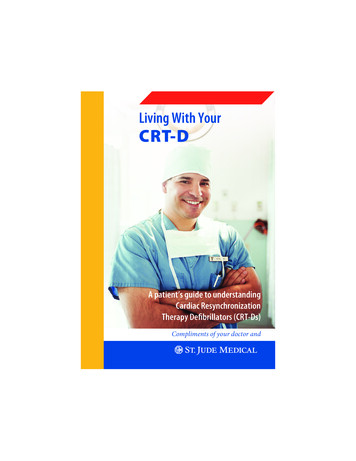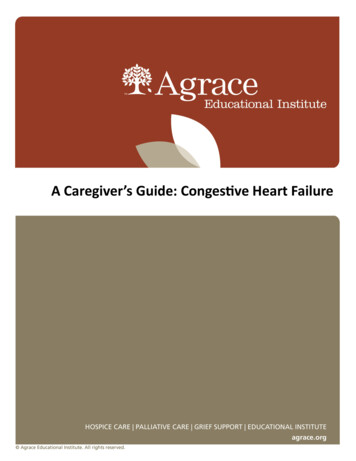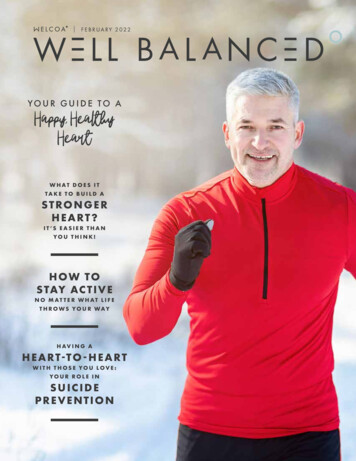
Transcription
FEBRUARY 2022YO U R G U I D E TO AHappy, HealthyHeartW HAT D O E S I TTA K E TO BU I LD AS T RO N G E RHEART?IT’S E AS I E R THANYO U T H I N K!H OW T OS TAY AC T I V EN O M AT TE R W HAT LI F ET H R O W S YO U R WAYH AV I N G AH E A R T-T O - H E A R TW I T H T H OS E YO U LOV E :YO U R RO L E I NSUICIDEPREVENTION
E AT W E LL½ cup kalamata olives, drained½ cup stuffed green olives, drained1 Tablespoon capers, drained1 clove garlic, minced1 teaspoon lemon juice1 Tablespoon extra virgin olive oilHeaping ¼ teaspoon fresh thymeleaves pulled from stems (About 2 sprigs)DIRECTIONS:O LI V ETapenadeThis Valentine’s Day, say “olive you” with this easy dip!It comes together in just 5 minutes. Add it to a romanticappetizer spread along with crackers or toasted crostini.Put kalamata olives, stuffed green olives, capers,minced garlic, lemon juice, extra virgin olive oil,and fresh thyme leaves in a food processor. Pulse5 or 6 times, until broken up but still chunky.Move to a serving bowl. Garnish with more freshthyme, if you like.SERVINGS: Makes ¾-1 cup of tapenade.Serves 8 people.NUTRITION INFO:Calories 41, Fat 4g, Carbs 1g,Protein 1g, Sodium 290mgWHAT IS TAPENADE?Tapenade is a spread made from olivesand capers. It comes from the Provence regionof France. The word itself is derived from tapenas,which means capers.Low calorie capers are immature flower buds.They contain fiber and antioxidants, as well asvitamins A, C, E, and K.Look for them in the center aisles ofmost grocery stores near the jarredartichoke hearts and olives.From the Kitchen of CADRY NELSON // Cadry is the writer, photographer, and recipe creator at Cadry’s Kitchen, a vegan food &lifestyle blog. She shares plant-based comfort food classics that are ready in about 30 minutes. Cadry has been featured on Today, NBCNews, Mashable, Reader’s Digest, Shape, and Huffington Post. For more, visit cadryskitchen.com.
E AT W E LLTREATYourselfOn Valentine’s Day it can feel like you’re obligatedto have dinner out at a restaurant. But on that nightof the year more than any other, restaurants arepacked. The staff is stretched thin, prices are higherthan usual, and it can feel impolite to linger.That’s why I prefer to make something specialat home. It’s less expensive. It’s healthier. Andyou can be as comfortable as you like. (Slippersencouraged!)finish with a sprinkling of Everything But the Bagelseasoning. Top with pickled red onions for a popof pink.At first it may look like the chips aren’t melting, butonce you start stirring, you’ll see how they lose theirshape.A serving of avocado delivers 26% of your dailyvalue of Vitamin K, 20% of folate, and 17% ofVitamin C. Plus, avocados contain more potassiumthan bananas!Work quickly and dip any of the following into themelted chocolate:More breakfast in bed ideas:Here are some at-home Valentine’s Day ideas toget the ball rolling.» Acai or smoothie bowl topped with fresh fruitand granolaBreakfast in BedBreakfast feels infinitely more fun when it’s servedon a platter with a flower and handwritten card.» Pancakes or waffles with maple syrupTo drink, make coffee and freshly squeezedorange juice. Enjoy the OJ on its own. Or serve itin a champagne flute with a few glugs of sparklingwine as a mimosa.» Polenta or grits» Breakfast potatoes with bell peppers andonionsOrange juice is packed with vitamin C, folate,and potassium.Sweet Treats That Will Make You MeltIt’s just not Valentine’s Day without chocolate. Youcould go to the store and buy chocolate dippedfruit. However, it’s easy to make at home with thehelp of your microwave.For the main event make that perennial favorite,avocado toast. Arrange the avocado in beautifullysplayed out slices on toasted whole wheat, andMicrowave ½ cup of semi-sweet chocolate chipsin a small bowl for about 50 seconds, stoppingonce halfway through to stir.» Strawberries or raspberries» Sliced bananas, apples, or oranges» Pineapple chunks» Pretzel sticks(Make sure you’ve thoroughly dried the fruit beforedipping. Chocolate sticks best to fruit that isn’t wet.)Put the chocolate dipped fruit onto a parchmentpaper covered plate. Then pop it into therefrigerator for 15 minutes to harden.Chocolate isn’t just delicious. It also containspowerful inflammation-fighting antioxidantsthat protect against cell damage caused by freeradicals.You’ll reap the most rewards from dark chocolate,which has been shown to lower blood pressure,balance the immune system, and improve brainfunction. Look for chocolate that has at least a 70%cacao content.Abou t CADRY NELSON // Cadry is the writer, photographer, and recipe creator at Cadry’s Kitchen, a vegan food & lifestyle blog. Sheshares plant-based comfort food classics that are ready in about 30 minutes. Cadry has been featured on Today, NBC News, Mashable, Reader’sDigest, Shape, and Huffington Post. For more, visit cadryskitchen.com.
BE WELLS IM PL E ST EPS TO AS TRON GE R H E A RTYour heart is a workhorse. It beats about100,000 times a day, pumping blood todeliver a continuous supply of oxygen andother vital nutrients to your entire body. So,if your heart isn’t functioning properly, it canaffect your overall health, and can even proveto be fatal.Fortunately, there’s a lot you can do to get yourheart healthier and keep it that way. Here aresome super simple-to-follow steps you can starttaking today to achieve better heart health.Walk around your block, your building, in thehalls, etc. The idea here is to simply move, andanything, even if it’s for 60 seconds counts! Anytype of movement and exercise helps to controlor modify many of the risk factors for heartdisease. Further, several studies have shownthat people who exercise regularly are lesslikely to suffer a sudden heart attack or otherlife-threatening cardiac event.Make small adjustments to your grocery list. Arecent study published in the journal EuropeanHeart Journal Quality Care Clinical Outcomes,indicated that more than two-thirds of heartdisease-related deaths worldwide can belinked to food choices.Experts note that small changes seem to workbest when it comes to diet because whenpeople try to make drastic changes theyusually don’t stick with them. Aim to add a fewmore fruits and vegetables to your grocery list.Whole grains, nuts, and seafood like salmonand tuna are also heart healthy options. Again,aim to gradually eat more of these types offood every week. Eating an apple instead of abag of chips are small swaps that can make abig difference.Have a cup of tea. According to a study inthe Journal of the American Heart Associationtea appears to slow the natural decrease inHDL cholesterol, also known as the “goodcholesterol”. The study monitored more than80,000 people over a six-year period andfound regular tea drinkers had a slowerage-related decrease in HDL levels. Thatdecline was linked to an eventual eight percentdecrease in cardiovascular risk among those inthe study.Carry your own groceries, laundry baskets,books, etc. The American Heart Associationand the American College of Sports Medicineboth recommend combining aerobic exercise(walking, swimming, biking) with resistancetraining (moderate weightlifting). Experts saythese two categories of exercise produce thegreatest benefit for preventing and managingheart disease. You don’t have to necessarilyhit the free weights to gain benefits. Simplycarrying your groceries, laundry, and othereveryday items is a great place to start.You control your heart health through diet, exercise, and managing stress!
BE WELLFloss. Poor oral health hasn’t been shown tocause heart disease, but several studies haveshown that people who have poor oral health(such as gum disease or tooth loss) have higherrates of cardiovascular problems such as heartattack or stroke. Regular flossing is a great wayto remove plaque and bacteria that’s missedeven with brushing and can help with youroverall oral health.Ask the Expert.How do I know if I’m at risk for heart disease?Several health conditions, your lifestyle, and your age and family history can increase your risk forheart disease. These are called risk factors. Anyone can get heart disease, but you’re at higher riskif you:» Have high cholesterol, high blood pressure, or diabetes» Smoke» Are overweight or have obesityWash your hands often. Infections like the fluand pneumonia can be very hard on the heart.Washing your hands before eating, after usingthe restroom, and after being in public placesis an easy and simple way to protect your heartand health.Do something every day to unwind. Stresstakes a toll on your heart health and cannegatively affect your blood pressure levels (akey risk factor for heart disease). Carve out timeevery day to do an activity that helps you relax.This can be deep breathing, walking with afriend, watching your favorite show—anythingthat helps you unwind.» Don't get enough physical activity» Don't eat a healthy dietSome risk factors for heart disease cannot be controlled, such as your age or family history. But youcan take steps to lower your risk by changing the factors you can control.WELL BALANCEDTM has an impeccable reputation for providing trustworthy information to improve yourwell-being and create healthier work cultures. Our network of physicians, dietitians, wellness professionals,and more are here to answer your crucial health questions.Have a question? Ask our experts by going to welcoa.org/expert. If your question is selectedwe will contact you directly with your answer and it will be featured in an upcoming issue.All questions are handled in confidence and will not, without prior consent, be disclosed or used by WELL BALANCEDTMor its contributors.
LIVE WELLLINE OFSightHow to Protect and Maintain Eye HealthWhen it comes to eye health many adults mistakenly believe that as longas nothing is bothering their eyes, there’s no need to get them checkedout. However, getting regular eye exams is very important, even if youthink your vision is fine. Eye exams allow an eye care professional tomonitor your eyes for common vision problems and signs of disease.There aren’t early warning signs for the most common eye diseases, soby identifying diseases early, you have the best treatment options and thebest chance of preserving good vision.If you haven’t had an eye exam in more than a year or at all, scheduleone now. A comprehensive exam will often include eye dilation. Afterchecking your vision sharpness, your doctor will place drops in youreyes to dilate (widen) the dark center of your eyes, called the pupil. Thisallows more light into your eyes, just like opening a door lets light into adark room. The doctor can then examine the inside of your eyes. Your eyedoctor will talk to you about the results of the exam and may prescribeglasses or other treatments. They’ll also let you know when you shouldcome back for another exam.Pro Tips to Protect Your PeepersHealthy habits that protect your overall health can also go a long wayto protect your eye health. These include not smoking, eating a healthydiet (especially dark leafy greens like spinach or kale), and maintaining ahealthy weight. Also, know your family’s history with eye health problems.Certain diseases can run in families. Additionally, there are simple stepsyou can take every day to keep your eyes healthy. Use these tips toprotect your eyes from things that can harm them.Wear sunglasses, even on cloudy days. Ultraviolet (UV) radiation fromthe sun can damage your eyes. Wear sunglasses that block 99 to 100percent of both UVA and UVB radiation every time you go outside.Wear protective eye wear. Safety glasses and goggles can protectyour eyes during certain activities, like playing sports, doing constructionwork, or doing home repairs. You can buy them from most eye careproviders and some sporting goods stores.Take eye breaks. People of all ages are spending more time focused ondigital screens, giving their eyes a marathon of a workout every day. Restyour eyes by taking a break every 20 minutes to look at something about20 feet away for 20 seconds.Practice good hygiene. Always wash your hands before you put yourcontact lenses in or take them out. Be sure to disinfect your contact lensesand replace them regularly.According to the CDC, an estimated 93 million adults in the UnitedStates are at high risk for serious vision loss, but only half visited aneye doctor in the past 12 months.
MOVE WELLForever!STAY FITAt the start of the year many people makeambitious resolutions around fitness.Unfortunately, by the time February rollsaround many of these resolutions have fizzledbecause they’re not realistic. Indeed, when itcomes to exercise, we often think about how toget fit, but so many of us fail because we don’tput time or effort into how to stay fit.Staying fit isn’t always easy, especially whenyou factor in busy schedules, nasty weather,and/or waning motivation. This isn’t to say it’simpossible though! Heed these tips to get andstay moving for the long haul.Focus on feelings. Yes, a great benefit ofregular exercise can come in the form ofa strong, sleek physique. But if outwardappearances are your only motivation, you’relikely setting yourself up for failure. As we ageit becomes more challenging to attain our idealphysique. You can certainly continue to worktowards it, but you may be disappointed andgive up if you’re not meeting these superficialgoals. Instead, focus on how exercising makesyou feel. For many, physical activity is a way torelieve stress, it makes them feel good, strong,and confident. Think about the immediatebenefits and feelings you’ll experience afterexercising—those are items that should keepyou motived to move forever.Identify what works for you. If previousexercise routines haven’t worked, don’t beatyourself up. Instead, think about what youenjoy and what could work for you. Maybethat means working out over your lunch hourbecause you never have time after work. Orperhaps it’s a walk in the morning before yourday begins. Think about what you like to doand when you’re most likely to actually do it.Think small. Remember that exercise doesn’thave to be a solid hour at the gym. Any type ofmovement for any period of time counts. A few10-minute walks over the course of the day cando the trick. Taking the stairs, having a walkingmeeting, getting up to stretch and get a fewsteps in every hour that you’re sitting can alladd to your daily physical activity goals.Grab a buddy. Having someone else toexercise with is a great way to make physicalactivity more fun, and it’s also an excellent wayto keep you accountable. Think of someone whomay want to join you on a walk, bike ride, etc.Plan for the day ahead. Planning is a criticalelement to staying active. Whether it’s bringinga pair of walking shoes to work, getting yourworkout clothes ready for the next day, orblocking out time on your calendar—preparefor the day ahead to help ensure you get yourexercise.Why Exercise Matters as We AgePhysical activity is particularly importantas we age. Regular exercise has beenshown to:» Keep your bones, muscles, and jointshealthy» Make you less likely to have thingslike diabetes, colon cancer, andosteoporosis» Manage stress and improve your mood» Lower your chances of heart disease» Help with your balance, so you're lesslikely to fall and break bones
CONNECT WELLTHE PART YOUCAN PLAY INSuicide PreventionA recent survey from the National ActionAlliance for Suicide Prevention revealed that 95percent of the respondents would do somethingif they knew someone who was contemplatingsuicide. However, 70 percent of thoserespondents identified barriers preventing themfrom discussing suicide with others, includingnot knowing what to say.One of the key factors for preventing suicide issocial connectedness. We can make sure ourfriends, family members, and neighbors whomay be struggling know they are not alone.Your Role in PreventionOne of the most important things you can do tohelp prevent a suicide is to know what to lookout for when a loved one is struggling. Warningsigns for suicide include:» Talking about wanting to die or kill oneself» Seeking a means to kill oneself, likesearching for options to harm oneself ortrying to buy a gun online» Reckless behavior accompanied with nofear of consequence» Talking about feeling trapped, being inunbearable pain, or being a burden toothersBeing able to recognize these warning signsand being able to take action can save lives.If you recognize any of these warning signs,ask the person directly whether they haveconsidered suicide. People are sometimesconcerned that if they bring up suicide,they might put the idea in someone’s head.However, research shows that is not the case.It’s best to be honest and direct. You could saysomething like, “I’ve heard you say you feel likeyour worthless and no one cares about you.Are you thinking about hurting yourself?” Showthem that you’ve noticed their behavior, areconcerned, and are there to help and supportthem.If you think someone is contemplating suicide,it’s always best to err on the side of cautionand seek professional help. Waiting to seekhelp can truly be the difference between lifeand death. You can visit the National SuicidePrevention Lifeline athttps://suicidepreventionlifeline.org. Theorganization provides 24/7 free confidentialsupport, and you can call or chat with one oftheir counselors for guidance. Their counselorscan walk through any concerns, either with youor the individual you are concerned about, andhelp you connect to needed support.According to the American Foundation forSuicide Prevention, the rate of suicide ishighest in middle-aged white men.
From the Kitchen of CADRY NELSON // Cadry is the writer, photographer, and recipe creator at Cadry’s Kitchen, a vegan food & lifestyle blog. She shares plant-based comfort food classics that are ready in about 30 minutes. Cadry has been featured on Today, NBC New
